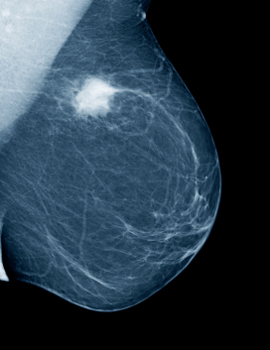A Brief History of Breast Cancer
NEWS & EVENTS | by Sarah Brechon | February 14th, 2012

This mammogram, showing an abnormality in the breast, is the modern way to diagnose breast cancer.
Is Breast Cancer a Modern Illness?
To the contrary: cancer has probably been around as long as humans.Skeletal remains of a 2,700 year old Russian King and a 2,200 year old Egyptian mummy have both been diagnosed with prostate cancers.
Breast cancer can also be traced right back to ancient Egypt, with the earliest recorded case described on the 1600 BC Edwin Smith Papyrus. Because breast cancer is quite outwardly visible in its most advanced state (seldom reached today thanks to modern medicine) it frequently captured the vision and imagination of our ancestors enough for them to record it.
Is Breast Cancer More Common Today?
You’ve probably heard people remarking how there seem to be many more cases of cancer around these days than there used to be. It is very hard to tell whether breast cancer is actually more common in today’s society, or whether our perception is skewed.
- We have much better diagnostic capabilities today so more cases are identified.
- More women are “breast aware.” Nowadays, women are more likely to perform breast self-examinations and get mammograms if they suspect that something is wrong. Women are more likely to receive routine clinical breast examinations at their doctors’ office, inevitably meaning that more cases are identified.
- Up until the 19th century, people died younger. Breast cancer develops more amongst older women, so this increase in life expectancy could be skewing perceptions.
- Women used to have more children at a younger age and breastfed for longer, all factors which lower the risk of breast cancer
Beliefs about the Cause of Breast Cancer
Throughout the ages, nobody has really been sure what causes breast cancer. Research still continues today.
Some of the earliest theories have long since fallen by the wayside. The Ancient Greeks, for example, believed that imbalances of bodily humors (fluids, especially black bile) were responsible for breast cancer.
But many other historic theories do still influence modern thought, with remnants of early beliefs left behind to form common breast cancer myths. In the 17th and 18th centuries, lots of possible causes of breast cancer were suggested:
- physical injury to the breast
- viral contagion
- blockages of the lymph glands
- repressed or over-indulged sexual urges
- curdled milk left in the ducts
- compression from tight clothing, which formed the basis of the bra myth
By the 19th century, the hopelessness of not knowing gave rise to a wave of psychological theories such as surgeon John Rodman’s bizarre suggestion thatbreast cancer was simply the fear of cancer.
It wasn’t until the mid 20th century, with the discovery of DNA that scientists could finally begin to understand the role of genetics in breast cancer.
Natural Ancient Remedies for Breast Cancer
Early remedies for breast cancer were aimed at offering temporary relief or prolonging life rather than attempting to cure the disease. The Egyptian Edwin Smith Papyrus echoed a sentiment which lasted many centuries when it pronounced: “There is no treatment.” Surgery was therefore generally avoided as futile and various herbal medicines or ointments preferred.
Common treatments used throughout history when treating breast cancer include:
- Purging of humors (Ancient Greece)
- Prayers and rites to the Gods (Greeks and Egyptians)
- Opium
- Castor Oil
- Licorice
- Sulphur
- Salves and Balms
- Cauterization
- Arsenic
The First Modern Breast Cancer Treatments
Modern breast cancer treatments only became commonplace once
- Scientists began to establish the relationship between breast cancer and genes
- Surgeons started viewing breast cancer as a localized disease (in just one area) which could be removed before it spreads
Both of these theories meant shifting away from beliefs about breast cancer relating to bodily fluids, viral contagion or sexual psychology. It now meant that breast cancer could be treated by isolating specific cells or removing affected areas; the beginning of the treatment known today as the mastectomy.
Around the 1750’s a number of surgeons, including Jean Louis Petit, Henri Le Dran, Claude-Nicolas Le Cat and Benjamin Bell, began performing breast cancer surgery removing lymph nodes and underlying muscle along with breast tissue.
These were the forerunners to the radical mastectomy, devised by William Halsted in the mid-nineteenth century. Halsted had the great advantage of developments in biological knowledge about cells and medical advances (anaesthetics, antiseptics and blood transfusions). He agreed with the theory behind removal of the breasts and underlying areas for breast cancer patients but was very concerned about spreading the cancer cells further. His contribution was a mastectomy which removed both breasts, lymph nodes and underlying muscles all in one piece. This became the standard breast cancer treatment until less radical, breast-sparing treatments began to be developed in the 1950s.
[Photo by iStockPhoto]

No comments:
Post a Comment